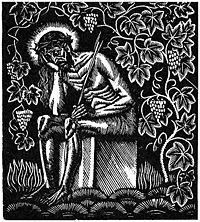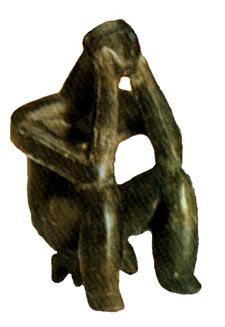
Pensive Christ
Encyclopedia


Iconography
Iconography is the branch of art history which studies the identification, description, and the interpretation of the content of images. The word iconography literally means "image writing", and comes from the Greek "image" and "to write". A secondary meaning is the painting of icons in the...
depicting a contemplating Jesus
Jesus
Jesus of Nazareth , commonly referred to as Jesus Christ or simply as Jesus or Christ, is the central figure of Christianity...
, sitting with his head supported by his hand with the Crown of Thorns
Crown of Thorns
In Christianity, the Crown of Thorns, one of the instruments of the Passion, was woven of thorn branches and placed on Jesus Christ before his crucifixion...
and marks of his flagellation
Flagellation of Christ
The Flagellation of Christ, sometimes known as Christ at the Column or the Scourging at the Pillar, is a scene from the Passion of Christ very frequently shown in Christian art, in cycles of the Passion or the larger subject of the Life of Christ. It is the fourth station of the modern alternate...
. It is therefore a picture of Jesus shortly before his crucifixion
Crucifixion
Crucifixion is an ancient method of painful execution in which the condemned person is tied or nailed to a large wooden cross and left to hang until dead...
, although more an andachtsbilder
Andachtsbilder
Andachtsbilder is a German term often used in English in art history for Christian devotional images designed as aids for prayer or contemplation...
or devotional subject than intended to show an actual moment in the narrative of the Passion of Christ. The Pensive Christ is much more common in sculpture than in painting, where the similar Man of Sorrows
Man of Sorrows
Among the passages in the Hebrew Bible that have been identified by Christians as prefigurations of the Messiah, the Man of Sorrows of Isaiah 53 is paramount - the various theological traditions are discussed at that article...
is more often depicted (in this Jesus is shown with the wounds of the crucifixion).
Development of the image
Similar images are known fron NeolithicNeolithic
The Neolithic Age, Era, or Period, or New Stone Age, was a period in the development of human technology, beginning about 9500 BC in some parts of the Middle East, and later in other parts of the world. It is traditionally considered as the last part of the Stone Age...
sculptures in Europe
Europe
Europe is, by convention, one of the world's seven continents. Comprising the westernmost peninsula of Eurasia, Europe is generally 'divided' from Asia to its east by the watershed divides of the Ural and Caucasus Mountains, the Ural River, the Caspian and Black Seas, and the waterways connecting...
, dating several thousand years before Christ.
The first known depictions of the Pensive Christ occur in northern German sculptures from the latter half of the 14th century, taking a pose already found in paintings of the preparations for the crucifixion, where Jesus sits in thought as the soldiers work to raise the cross. Before this the pose had been used for the figure of Job in Distress, according to typology
Typology (theology)
Typology in Christian theology and Biblical exegesis is a doctrine or theory concerning the relationship between the Old and New Testaments...
one of the prefigurements of Christ. Art historians link its appearance with the Devotio Moderna
Devotio Moderna
Devotio Moderna, or Modern Devotion, was a 14th century new religious movement, with Gerard Groote as a key founder. Other well known members included Thomas à Kempis who was the likely author of the book The Imitation of Christ which proved to be highly influential for centuries.Groote's initial...
(Latin for "modern devotion"), which stressed the human nature of Jesus, a model for the faithful to follow. The image became especially popular in Silesia
Silesia
Silesia is a historical region of Central Europe located mostly in Poland, with smaller parts also in the Czech Republic, and Germany.Silesia is rich in mineral and natural resources, and includes several important industrial areas. Silesia's largest city and historical capital is Wrocław...
and Pomerania
Pomerania
Pomerania is a historical region on the south shore of the Baltic Sea. Divided between Germany and Poland, it stretches roughly from the Recknitz River near Stralsund in the West, via the Oder River delta near Szczecin, to the mouth of the Vistula River near Gdańsk in the East...
, and then Poland and Lithuania
Lithuania
Lithuania , officially the Republic of Lithuania is a country in Northern Europe, the biggest of the three Baltic states. It is situated along the southeastern shore of the Baltic Sea, whereby to the west lie Sweden and Denmark...
, where it became strongly entrenched in folk art wood carvings by dievdirbiai
Dievdirbiai
Dievdirbys are Lithuanian wood carvers who create statues of Jesus and the Christian saints...
(Lithuanian folk carvers; example below).
A related image, the Herrgottsruh ("Repose of the Lord" in German), does not have the chin resting on a hand; Christ sits, often with hands crossed in his lap. This appeared in Italian painting at the end of the 14th century, and soon spread to sculpture in southern Germany and Austria.
The Thinker
The Thinker
The Thinker is a bronze and marble sculpture by Auguste Rodin, whose first cast, of 1902, is now in the Musée Rodin in Paris; there are some twenty other original castings as well as various other versions, studies, and posthumous castings. It depicts a man in sober meditation battling with a...
by Auguste Rodin
Auguste Rodin
François-Auguste-René Rodin , known as Auguste Rodin , was a French sculptor. Although Rodin is generally considered the progenitor of modern sculpture, he did not set out to rebel against the past...
has a similar pose, and may be based on the traditional sculptures.
External links
- Photographs of folk figurines of Pensive Christ in LithuaniaLithuaniaLithuania , officially the Republic of Lithuania is a country in Northern Europe, the biggest of the three Baltic states. It is situated along the southeastern shore of the Baltic Sea, whereby to the west lie Sweden and Denmark...
(in LithuanianLithuanian languageLithuanian is the official state language of Lithuania and is recognized as one of the official languages of the European Union. There are about 2.96 million native Lithuanian speakers in Lithuania and about 170,000 abroad. Lithuanian is a Baltic language, closely related to Latvian, although they...
) http://www.tradicija.lt/Siuzetai/BA_Rupintojeliai_a.en.htm

